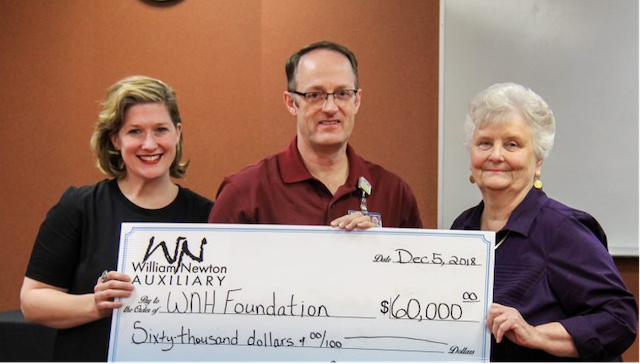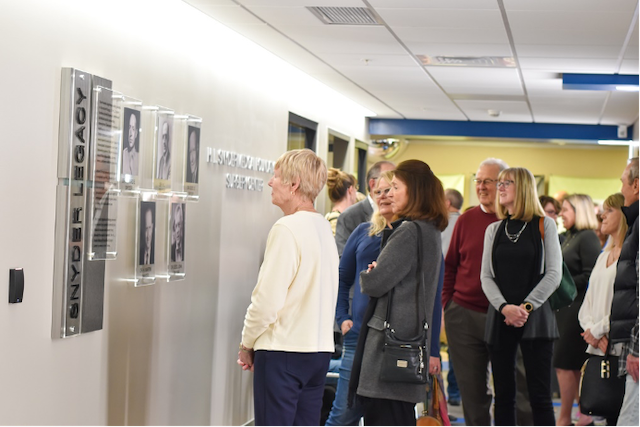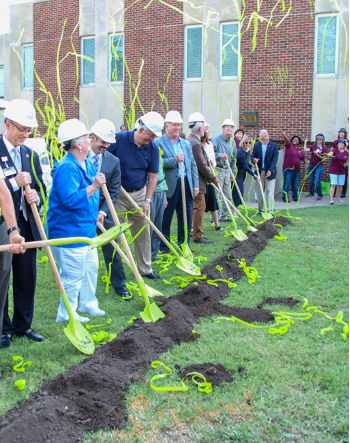11 Ways a Rural Hospital Transforms Community Perceptions to Exceed Campaign Goals
Annika Morris
Published: 02/03/2021

Photo, left to right, accepting donation from William Newton Hospital Auxiliary are: Annika Morris, CFRE, Director of the William Newton Hospital Foundation; Ben Quinton, CEO of William Newton Hospital; Georgia Larson, 2018 Foundation President.
The prospect was daunting at first. How would we transition a fiscally conservative community of donors from “I’m willing to consider a token gift if the hospital has its back against the wall” to “I never thought we would give
$1 million dollars?" But that is just what we did. “This campaign has shown us how important the hospital is to the community on so many levels and that we should be supporting an agenda of excellence,” says Paula Radcliff, campaign co-chair.
The Second Century Campaign transformed the Winfield, Kansas and surrounding communities’ perspective on William Newton Hospital (WNH), which will celebrate its 100th anniversary in 2027. In the short term, the campaign provided
funding to enhance the strategically important surgery center. Long term, however, the campaign altered citizens’ perspectives on well-being so they now view the hospital as a cornerstone of the region’s economy and future vitality. The
results were notable:
- Exceeded phase one goal of $3 million dollars with $4.6 million raised to expand a strategically important surgery center.
- Increased total donors from 740 to 2,013 (a 272% increase).
- Reignited a legacy program with $1.6 million in additional planned gifts.
- Positioned the hospital to pursue its long-term aspiration of funding a 10-year master facility plan of six phases.
Through this process, we found a profound opportunity to meld hospital and community aspirations together in a way that instilled a deep sense of community pride and excitement. This became bigger than just a hospital fundraising effort. It was
a campaign for our community.
So, how did we achieve this wonderful success?
1. Realistically acknowledge challenges you will have to overcome.
Hospital leaders were initially anxious about how to approach funding a 10-year, $10-million master facility plan without a long tradition of philanthropic support from campaigning. The last thing anyone wanted was failure—especially a public
one. There were valid reasons for concern:
- A hospital in a neighboring town was failing and regularly in the news.
- Many residents did not understand our financial model and mistakenly thought we received tax support.
- As a 25-bed hospital in a rural, four-county service area, we lacked big city resources to draw upon.
- As the foundation director, my experience was limited to mostly events and relationship management. I had never been in a campaign or true major gift fundraising.
- For many years, the hospital had raised funds through a gala and benefit auction.
- This would be only the second capital campaign since the hospital’s founding almost 100 years ago!
In spite of these challenges, we knew philanthropic funding was going to be absolutely necessary if we were to make the investment necessary to continue providing high quality care and outcomes to area residents.
2. Before you launch, talk to your potential donors… a lot!
Our thoughtfully designed campaign planning study proved to be crucial. We talked at length to potential donors and learned what was most important to the community and how this project fit into their aspirations. We held ‘Visioning Sessions’
to present plans and facilitate discussion to determine where consensus and passion were strongest. We encouraged key potential donors and allies to talk about what they wanted our community to look like in the future. Through this approach, we were
able to build a sense of ownership and enthusiasm among local leaders that would prove essential to our success.
We asked repeatedly, “What do people need to know and why is it important?” Their answers provided us with compelling context, urgency, and relevance we would articulate in our case for philanthropic investment. Because
we incorporated their perspectives, we were able to strike the right chord early in our donor visits and to facilitate an authentic conversation about the future of the community and the role of the hospital. We developed the campaign through a real
community dialogue with wonderful results. This allowed us to emphasize the more compelling opportunities to advance the “enterprise” of caring for the community over just funding a series of building projects. That made a huge difference.
3. From the start, engage your senior administrators––they are critical to your success.
We were fortunate our CEO, Ben Quinton, MHA, was open to accepting feedback, taking community members on tours, and partnering with other organizations to make sure the hospital and the community are successful. But we also worked hard to help our CEO
understand just how important his involvement would be. This would be his first campaign as well as mine.
“As the hospital’s CEO, it’s tempting not to get too involved because you’re so busy," said Quinton. "It is easy to say to Annika, ‘You’re the foundation director. Just go raise money.’”
He understood from his experience with board members, however, that leading citizens would want to know from the CEO why this was so important to the larger “vision” and “enterprise” of community well-being and economic
vitality.
“I looked to our foundation director for her expertise and judgement on where and when I could be most helpful. I’ve learned when we focus on education and outreach—not just going out and knocking on people’s doors and asking for
money—but also asking them to get involved and be part of this exciting project, it turns out very well. It has been an investment of my time that has paid very large dividends.”
4. Develop community partnerships to build ownership, credibility, and influence.
While individual giving remains the top source of our philanthropy, the Second Century Campaign cabinet also connected to key partners throughout the service region. These included the hospital auxiliary, hospital employees, and community organizations. William
Newton Hospital’s Auxiliary were, in fact, the first ones to step up with a $250,000 pledge!
Building on the excitement of the first six-figure pledge, our foundation and campaign committee focused on other natural partners, the hospital’s physicians, nurses, and staff. In what turned out to be a wonderful decision, we recruited a retired
and well-respected nurse to spearhead the employee campaign.
Under her leadership, we spent time educating and building awareness among both current and retired employees. We visited with staff on all three shifts to hand out ice cream and make sure everyone was aware of how to get involved in the campaign effort.
Emphasizing easy-to-use giving options like paid time off (PTO) and payroll deduction tripled employee engagement over two years. At least two people in our rural health clinics gave 40 hours of PTO per year, an astounding amount of support.
Like most smaller communities fortunate to have a hospital, you can’t walk down the street and not bump into someone who’s been impacted or connected to William Newton Hospital. The employee campaign theme, “WE are William Newton,”
really resonated with the community.
“Without our amazing employees, we wouldn’t have what we have, and we wouldn’t be able to do what we do," our CEO said. "Our employees pull together when there are needs that come up. They are just so committed to doing the
right thing for others.”
5. Maximize the impact of your naming opportunities.
Personal and powerful connections to our hospital made a tremendous difference. In addition to the hospital’s auxiliary and employees, the Second Century Campaign resonated with well-respected local organizations like the H.L. Snyder
Medical Foundation. Paula Radcliff, our campaign co-chair, presented to a group of the key members of that foundation because the hospital and a Snyder surgeon saved a relative’s life years before. As a result, they had a special interest
in helping us.
Through our co-chair’s relationship, the hospital’s long-term engagement with the organization, and the strong case we had put together all combined to result in a naming opportunity gift that resonated with real meaning and positive associations.
When you talk with potential donors, listen for those connections––they can make a huge difference.
“When the new surgery center opens, we’ll have five photos, one of each Snyder-connected surgeon, with his history on the wall," Paula said.
The naming opportunities highlighted a larger narrative about community collaboration and celebrated key individuals and families to become a part of our collective story.
 Guests admire Snyder Legacy Wall at the VIP Donor Reception of H.L. Snyder Medical Foundation Surgery Center, January 2020.
Guests admire Snyder Legacy Wall at the VIP Donor Reception of H.L. Snyder Medical Foundation Surgery Center, January 2020.
6. Stress that your hospital is also an important business partner.
While the Snyder Foundation’s gift is rooted in history, the six-figure gift from Winfield Economic Development, Inc. (WED) emerged because of William Newton Hospital’s influence on the region’s future ability to attract businesses and
families.
The American Hospital Association’s 2019 Rural Hospital report noted, “Nearly 20 percent of Americans live in rural areas and depend on their hospitals as important – and often the only – sources of care in their communities.”i Furthermore, 64 percent of at-risk rural hospitals are considered as important to the economic well-being of their communities as they are to citizens’ healthcare, according to a study by Navigant.ii
In response to our carefully crafted presentation and proposal to WED, we received a $500,000 challenge grant to inspire the corporate community to invest in the hospital in significant ways. WED realized that William Newton Hospital plays a highly influential
role in its recruitment of businesses and corporate branches.
In August 2018, during remarks at the surgery center’s groundbreaking, WED President Rodger Steffen said, “Our board’s appreciation for William Newton Hospital’s role in our community has grown exponentially. This challenge gift
was designed to diminish any potential of our taking our community hospital for granted.”

7. Publicize your leadership Gifts because other prospects are listening.
In December 2018, the CEO of a major local bank responded to WED’s challenge with a call to the hospital’s foundation; He wanted to invite bank employees to participate in giving.
Over the next four months, the campaign corporate committee and foundation director worked with the CEO and his team. The result was $90,000 in donations from bank employees and included a combined estate and corporate gift. Once again, personal connections
made a difference.
As the bank CEO noted, “Everybody here at the bank cares about our hospital. Some of us were even born there. The community support you provide lays a foundation for physicians to practice here and for the hospital to provide quality
care––whether it is scheduled or emergency. We need this hospital. I can’t thank you enough.”
8. Stress that fundraising means quality care AND financial security.
For decades before the transformation, WNH’s board and key leaders delivered quality healthcare in a quiet, understated way. They cited the following framework for their success:
- WNH is legally affiliated with the city of Winfield but receives no tax support (a positive among residents).
- WNH regularly operates in the black while 20% of rural hospitals risk being closed.iii
- In the past 77 years, only three CEO’s have led the organization, an average tenure of 25 years in an industry notorious for turnover.
- Winfield’s City Commission appoints the hospital board of community members who have no term limits.
William Newton Hospital’s high level of quality care with sound fiscal management is an oft-cited basis for success and communicates that we are a good investment to future donors.
“We’re very fortunate that we can be a profitable rural hospital as many are struggling,” CEO Ben said. “We focus a lot on growth. I’ve been a CEO of hospitals for 15 years, and if you’re not growing, you’re not
surviving. We’ve grown tremendously, adding 71 jobs and new service lines in the last several years. We manage our costs wisely, but that’s not the only thing. We are constantly looking for ways to deliver better care, locally.”
Because of access to such qualified caregivers, during the Second Century Campaign, community members often cited exceptional healthcare outcomes and the dedicated staff at William Newton Hospital as reasons for being involved.
9. Don’t forget planned giving.
Several conversations with a local couple about support for the surgery center developed into an anonymous, transformational gift that further seeded the planned giving society (William Newton Hospital Heritage Society) headed today by a strong team of
community volunteers. Over time, that society will also become a major source of philanthropic support––and it began during this campaign.
10. Ensure you have the supporting resources you will need.
We knew that as a staff and organization, we lacked campaign experience and might only have one chance to engage the community the right way. Our fiscally conservative community meant that our hospital leaders were cautious about spending significant
funds on outside help from consultants or on additional staff. However, the failures of a rival hospital instilled a real sense of risk and a clear image of what we did not want.
Ultimately, our board and staff leaders decided money would need to be invested wisely to generate the quality outcomes we sought. We carefully selected a consulting firm, Rogge + Associates out of Charleston, SC, with whom we felt a connection
and believed would complement us well. For us, working with a consulting firm was invaluable to building the right team, getting the guidance we were looking for, and having supporting resources to succeed. It allowed us to be our best. Our CEO’s
involvement, our wonderful campaign volunteers, our generous donors – we would not have had the success we did without their involvement and commitment.
The big takeaway here is to take an honest inventory of your needs and seek the complementing pieces, whoever or whatever they may be, to prepare you to succeed.
11. Don’t be surprised how visible you will become in the community.
Today, William Newton Hospital and foundation leaders are regularly invited to participate in city planning meetings, chamber of commerce efforts, and community vision casting––all a result of the spotlight that the Second Century Campaign shined on the hospital’s absolute essentiality to Winfield and the surrounding region.
My perspective on fundraising as a profession has also changed during the Second Century Campaign. Six years ago, when I said yes to leading the William Newton Healthcare Foundation, people avoided me in the grocery store because they were afraid
I was going to ask for money in the frozen vegetable aisle.
Ultimately, there were about 70 active volunteers and hundreds of donors who made this happen. I feel very privileged to be a part of it. I would say my role was to orchestrate the matching of donors with how they want to give.
I can see why some people wouldn’t stick with it, but I fell in love with it even more during the process of the campaign, and it became much easier to ask people for support because as we focused on people in the region, this became a calling,
not a job. Now it’s fun and a lot easier.
For all of us, the Second Century Campaign would become so much more than a fundraising campaign. It became a pivotal and celebrated collaboration where the vision and aspirations of the hospital and community became one. People now
see us as a vital pillar of our community, a source of enthusiasm and pride, and the key to a promising and healthy future.
i “Rural Hospital Report.” American Hospital Association. February 4, 2019.
On-demand Learning Hub
Explore all our resources on this and many other topics in the On-demand Learning Hub